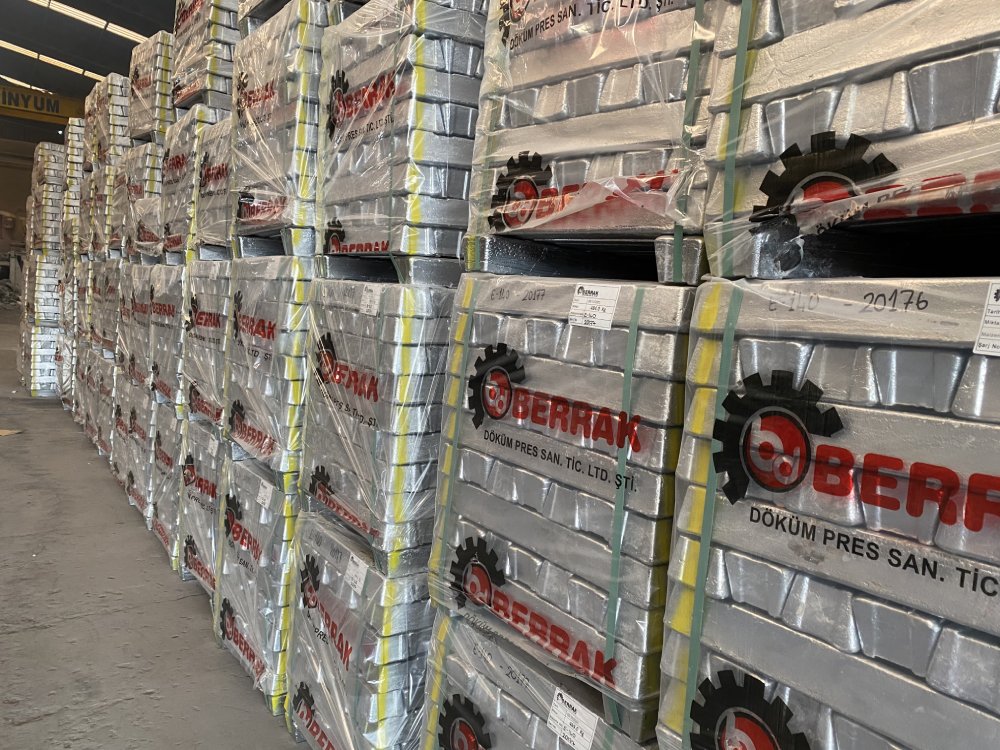- info@berrakdokum.com.tr
- +90 232 437 01 38
- Egemenlik Mah. 106/4 Sk. No:38 Işıkkent-İZMİR
Aluminum Ingot

Aluminum
- Aluminum ranks second after iron and steel alloys in terms of application on an industrial scale. The rapid development of Aluminum industry is related to various and unique properties that have made it one of the most suitable engineering and structural materials.
- Aluminum is included in the category of lightweight metals, but the strength of some Aluminum alloys is higher than construction steels. It has good electrical and thermal conductivity and is considered a good reflector for light and heat. In most applications, Aluminum has high corrosion resistance and is a non-toxic metal.
- Aluminum alloys can be cast or fabricated in various forms and have a variety of surface finishes. With all these extensive properties, it is not surprising that Aluminum alloys are of prime importance among engineering materials.
How to produce pure Aluminum
- Aluminum is the most abundant metal in the earth's crust, but it is often used in combination with other elements such as iron, silicon and oxygen. Bauxite, which is basically hydrous Aluminum oxide, is the most basic ore used to produce this metal.
- First, pure Aluminum oxide (alumina) is extracted from bauxite with the help of Bayer process. The extracted oxide is then regenerated in the Hall process and in the vicinity of a molten cryolite bath with the help of anode and carbon cathode, and is placed in the form of molten Aluminum at the bottom of the electrolyte furnace.
Production of Aluminum alloys
- After high purity raw Aluminum has been produced, it is now possible to produce Aluminum alloys in different types by adding suitable alloying elements. The raw Aluminum ingot is remelted in special furnaces and various alloy elements are added to the melt in a mixture and with a specific weight percentage, and after slag formation and separation of impurities, the desired Aluminum alloy is ready for production and use.
Casting Aluminum Alloys
- Casting Aluminum alloys are highly developed due to having suitable casting properties such as good fluidity, ease of feeding as well as strength, ductility and corrosion resistance.
- They are known by 3-digit codes where the first digit indicates their group and the next two digits indicate the purity of Aluminum in the alloys.
- The 6 main groups of Aluminum casting alloys are 200, 300, 400, 500, 700 and 800, which are described below regarding their properties.
- It should be mentioned that in order to achieve casting properties and increase fluidity, silicon is the base of all these alloys.
- The main alloying element in these materials is copper. Of course, recently these alloys have been replaced by Aluminum-silicon-magnesium cast alloys, and the main reason for this replacement is the better casting properties of Aluminum, silicon, magnesium alloys, as well as better corrosion properties and lower specific weight, while the mechanical strength is almost equal to each other. But also, some series of this alloy such as 222 and 242 are used for casting pistons.
- The alloys of this category include Aluminum-silicon-magnesium alloys or in some cases copper. This category is one of the most widely used Aluminum casting alloys.
- Alloys such as 308, 319, 333 and 354 are used to make some permanent molds, parts of car engines and their cylinder heads, as well as making some airplane and rocket parts.
- 400 series alloys are the simplest and most widely used casting alloys. The main alloying element related to these alloys is silicon, which is usually added more than 5%. These alloys are used for casting parts with complex geometry.
- Alloys 413 and 433 are in this category and are used for the most common sand-casting molds.
- These alloys are produced from the combination of Aluminum and magnesium and have limited applications. Today, in most cases, group 300 is used instead of this group.
- Today, this series of alloys is not used, and in fact, this group does not have functional alloys
- These cast Aluminum alloys are created by adding zinc and tin alloy elements, respectively. The application of these alloys is very limited and specific.
200 series cast Aluminum alloys
300 series cast Aluminum alloys
400 series cast Aluminum alloys
500 series cast Aluminum alloys
600 series cast Aluminum alloys
700 and 800 series cast Aluminum alloys





